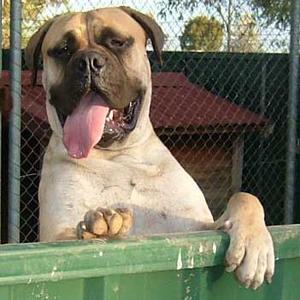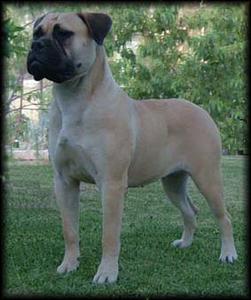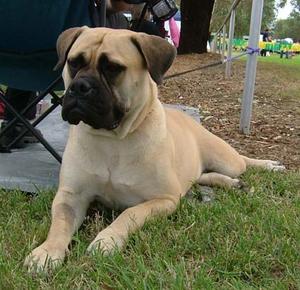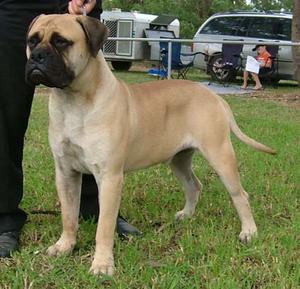BULLMASTIFF
In the beginning Mastiffs were used but Gamekeepers found the Mastiff was too large and cumbersome and unfortunately didn't leave too much of the poachers behind. Some poachers were only children of around 10 years of age.
Gamekeepers then started their search for a dog that was strong, silent, fearless, agile and powerful enough to be able to run down and knock the poacher to the ground. They also required a breed that would not maul the poacher but only hold them until help came from the Gamekeeper.
Obviously all of these traits would not be found in one breed of dog. Many crosses between Mastiffs and Saint Bernard's Labradors and Great Danes were trailed until they had success with the Mastiff for its power, trustworthiness, fearsome appearance and loyal nature and the Bulldog for its tenacity, silence and agility. Hence the Bullmastiff which consisted of 60% Mastiff and 40% Bulldog. The Bullmastiff is a dependable loyal guarding breed, which earned the respect of the Gamekeeper not just as a guard dog but as well as a family dog.
Even though records have shown that the cross of a Mastiff Bulldog type found in editorials as early as 1795 it wasn't until 1924 that Bullmastiffs were to be judged but three generations of breeding of Bullmastiffs was required for Bullmastiffs to be registered as purebreds. Thankfully to the dedication of Mr. J. Biggs of Osmaston Kennels, Mr. J Barrowcliffe, Mr. J Barnard, Mr. S. E. Mosley of Farcroft Kennels and Mr. V. Smith of Pridzor Kennels, Bullmastiffs attained full registration in 1927. Challenge certificates were issued as of 1928 to make up the title of Champion. The first show where Challenge Certificates were issued was the 1928 Crufts Show judged by H. R. Brown Jr. Dog challenge was awarded to Mr. V J Smiths Tiger Prince and bitch challenge was awarded to Mr. S. E. Mosley's Farcoft Silvo who also went on to be the first Bullmastiff titled Champion. The first dog to be titled Champion was Tiger Prince.
To have a better understanding of the breed standard we as breeders today need to understand the importance of the history of our breeds.
The original colour choice was brindle. The reason behind this being that it made him very easily camouflaged into the background and the darkness of the night, thus making him less detectable. The characteristic wrinkling on the dogs? forehead was used as a silent warning to the gamekeeper to beware. That is why the standard calls for the dog the have wrinkling when interested but not when in repose.
As a working dog, it was quickly discovered that dark toenails wore better than the light coloured ones and that a short weather-proof coat protected the dog from weather and did not allow sticks or debris to catch in it to slow him down or stop him. These points as well as many others are still reflected in today?s breed standards






